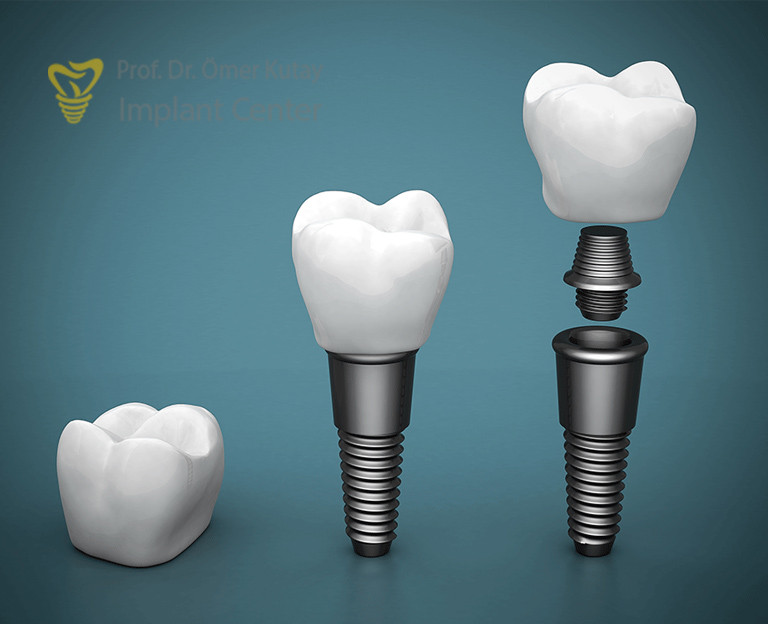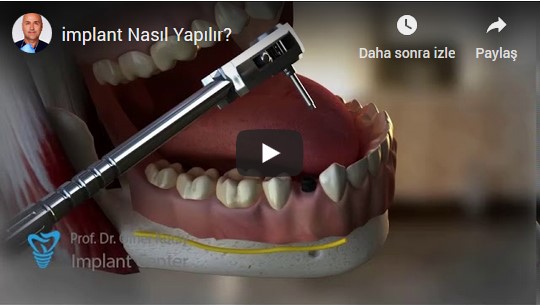How Is Implant Made? People who have problems with their teeth but do not prefer traditional solutions such as dentures and cannot make a decision, wonder how the implant procedure is done. First of all, the patient should know that implant treatment is a form of treatment in which methods that vary from person to person are used.
The patient's bone and facial structure, bone density and amount determine the type of oral health implant and the way it is applied. A personalized treatment plan is followed for each patient.
The implant is a material made of titanium in the form of a screw, which is placed in the jawbone and suitable for root anatomy. It is designed to act as a tooth root. A tooth-shaped crown is placed on this screw-shaped implant as a prosthesis. This crown is also usually made of zirconium or metal-supported porcelain.

The implant can be applied in four different ways in general. In the first method, the tooth is extracted and the implant is placed immediately in the formed space. This is the most comfortable and practical method for the patient and the doctor. It does not require stitches and surgical intervention, it is almost never painful. The second method is the closed technique. In this method, laser is used without opening the flap (without cutting the patient's tissue to be implanted) and a cavity is created. The implant is placed in this cavity.
It is a comfortable, painless and one-stage procedure, it takes a very short time. The third method is for mini-implants. In this method, direct implant application is made over the mucosa. The fourth method is the most well-known classical surgical method among the public; With the surgery, a suitable gap is opened in the person's jawbone, the implant is placed there and the stitches are removed after about a week. In this method, if the person's bone density is low, another procedure called bone grafting is performed beforehand.
How is the prosthesis attached to the implant? Since the implant replaces the root of the tooth and must fuse with the bone, a permanent denture is not placed on it immediately. Depending on the preferred method and the age of the person, it is expected that the implant will be well fused to the bone for 3 to 6 months. The permanent prosthesis (the part known as the denture) is only fitted after this period. The success rate of implants is between 90 and 95% for the first five years. Then this rate gradually decreases.

Prof. Dr. Ömer Kutay has been providing treatment services to implant patients since 1992 in Istanbul. Ömer Kutay, an implant and prosthetic dentistry specialist, offers his patients the chance to return home with their new teeth on the same day they come to the clinic, especially with the "Implant in a Day" treatment.
Patients with loose-shaking and unsightly teeth, who neglected to be treated on time, benefit most from this treatment. These patients not only get rid of cavities and bacteria in their mouths after the treatment, but also have a high self-confidence as a natural result of their new attractive smile.
Other suitable patients for treatment are those who have difficulty in using removable palate prostheses, those who experience osteoporosis due to tooth and gum diseases, those who have genetically missing teeth, and those who experience tooth loss after an accident.
How to apply dental implant? Implant and prosthetic dentistry Prof. Dr. Ömer Kutay answers frequently asked questions. Successful dentist explains how to apply the implant:
“The dental implant can be applied with a very simple surgical procedure. Whether the tooth is extracted immediately or to be applied to replace a previously extracted tooth, the dental implant is placed in the jawbone with a simple procedure done in a tooth extraction.”
Applying an implantLet's say we've extracted a tooth, and we're going to put an implant in place of the extracted tooth. As soon as the tooth is extracted, the implant can be easily placed in the extraction cavity. Because the slot where the implant will be placed is ready. It doesn't make a difference whether it is anterior or posterior teeth. If the socket of the extracted tooth is smooth, it is possible and very easy to place the implant there.
If the implant is to be placed in place of a previously extracted tooth, it is necessary to open a slot for the implant in that area. In order to open a socket in the bone where the implant will be placed, the socket is prepared with the drills going from thin to thick, which pierces the bone, and the implant is placed. In the meantime, the gingiva is cut and lifted, exposing the bone and providing a direct view. Or, in the option called the closed method, a small hole is made and the implant is placed through that hole, and this process is completed without stitches since the gingiva is not removed.
One of the most frequently asked questions about implant treatment is whether pain is felt during the operation. One of the most searched topics about implants on the internet is whether there is pain during the operation. Implant and prosthetic dentistry expert. Dr. Is there any pain during the Ömer Kutay implant application? answers the question:
“There is no pain during the application of the implants. Patients mostly say, 'you will make a hole in my bone and who knows how much it will hurt?' There is no such thing. Because the nerve tissue in the bone is much less in quantity than in the soft gums, so the bone is not such a painful tissue. It is a tissue with less vitality and nerves. For him, opening a socket in the bone is not a painful procedure at all. We know that after careful implant placement, patients do not suffer, even on the same day.
We know that when there is inflammation in that area and these are cleaned or larger operations are performed, the pain is a little more. A scale can be given here. Let's say that the maximum pain will be 10, and the pain to be taken after the implant will be a maximum of 6 out of 10. Generally, we start the patient with an antibiotic and a pain reliever the day before the implant treatment. This drug application, which was started one day in advance, is already found in the blood circulation during the construction of the implant. Thus, the pain after the implant has been reduced to 2 out of 10, and sometimes there may be no pain at all.”